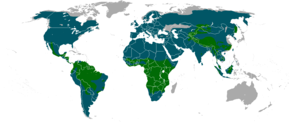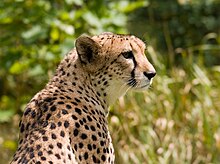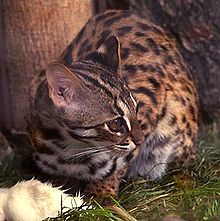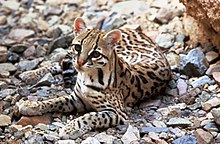Felidae
| Felidae[1] | |
|---|---|

| |
| Clockwise from top left: tiger (Panthera tigris), Canadian lynx (Lynx canadensis), cougar (Puma concolor), cheetah (Acinonyx jubatus), wildcat (Felis silvestris), serval (Leptailurus serval), caracal (Caracal caracal) and ocelot (Leopardus pardalis). | |
| Scientific classification | |
| Domain: | Eukaryota |
| Kingdom: | Animalia |
| Phylum: | Chordata |
| Class: | Mammalia |
| Order: | Carnivora |
| Suborder: | Feliformia |
| Superfamily: | Feloidea |
| Family: | Felidae Fischer von Waldheim, 1817 |
| Type genus | |
| Felis | |
| Subfamilies | |

| |
| Felidae ranges | |
The biological family Felidae is a lineage of carnivorans that includes the cats. A member of this family is also called a felid.[3][4][5][6]
The characteristic features of cats have evolved to support a carnivorous lifestyle, with adaptations for ambush or stalking and short pursuit hunting. They have gracile and muscular bodies, strong flexible forelimbs and retractable claws for holding prey, dental and cranial adaptations for a strong bite, and often have characteristic striped or spotted coat patterns for camouflage. Cats are obligate carnivores, meaning they are dependent on nutrients in animal flesh for survival, and because of the large proportion of meat in their diet are sometimes referred to as hypercarnivores. Of the 13 terrestrial families in the order Carnivora, they are the strictest carnivores.[7]
Living cats belong to two subfamilies, the Pantherinae and Felinae. The former comprises the "big cats" (the tiger, lion, jaguar, leopard, snow leopard, clouded leopard and Sunda clouded leopard).[5] Felinae comprises all the non-pantherine cats,[8] which range in size from the small rusty-spotted cat to the big cat-sized puma and includes such diverse forms as the lynx, ocelot, serval and cheetah, as well as the domestic cat.
The first cats emerged during the Oligocene, about 25 million years ago, with the appearance of Proailurus and Pseudaelurus. The latter species complex was ancestral to two main lines of felids, the cats in the extant subfamilies and a third major group of extinct cats, which are assigned to the subfamily Machairodontinae. The machairodonts included the saber-toothed cats such as the Smilodon. The "false sabre toothed cats", the Barbourofelidae and Nimravidae, are not true cats, but are closely related and together with Felidae and other cat-like carnivores (hyaenas, viverrids and mongooses) make up the feliform carnivores.
Evolution
The 41 known cat species in the world today are all descended from a common ancestor.[9] Cats originated in Asia and spread across continents by crossing land bridges. Testing of mitochondrial and nuclear DNA revealed that the ancient cats evolved into eight main lineages that diverged in the course of at least 10 migrations (in both directions) from continent to continent via the Bering land bridge and the Isthmus of Panama, with the Panthera genus being the oldest and the Felis genus being the youngest. About 60% of the modern cat species are estimated to have developed within the last million years.[10]
Felidae's closest relatives are thought to be the Asiatic linsangs.[11] Together with the Viverridae, hyenas, mongooses, and Madagascar carnivores, they form the suborder Feliformia.[12]
Most cat species share a genetic anomaly that prevents them from tasting sweetness.[13]
Most cat species have a haploid number of 18 or 19. New World cats (those in Central and South America) have a haploid number of 18, possibly due to the combination of two smaller chromosomes into a larger one.[14]
Domestic cats may either have a long or short tail. At one point, biologists had to consider whether the short tail also found in the lynx was the ancestral or derived trait. Without looking at the fossil record, researchers were able to look at the character states found in their outgroups. Because all animals belonging to Felidae’s sister taxa, Viverridae, have long tails, scientists could infer that this character state represents the ancestral trait.[12]
Some domestic cats display a rosette pattern on their coats. This character state, however, is not related to the rosettes found on big cats. Domestic cats and big cats underwent convergent evolution for this trait. The most common ancestor to all cats had a flecked coat. Lynxes display this character state. The jaguarundi lost this character state secondarily. The most common recent ancestor of snow leopards, tigers, jaguars, lions, and leopards developed a coat with rosette patterns from the flecked patterns. Tigers and lions, however, do not display rosettes as adults. They both have lost this ancestral character state over time. Adult tigers actually display elongated rosettes that now appear as stripes. Adult lions seem to lack any distinctive markings altogether. Both juvenile tigers and lions, however, display partial rosettes. This ancestral character state appears only during these early stages, supporting the notion that ontogeny reflects phylogeny. The rosette patterns found on snow leopards, jaguars, and leopards all have a common origin.[15]
Carnivores compete against each other. There is fossil evidence that felids have been more successful than canids in North America.[16][17]
Characteristics
Cats are obligate carnivores, requiring a diet of meat and organs to survive. Aside from the lion, wild felids are generally solitary; feral domestic cats do, however, form colonies. Cheetah males are also known to live and hunt in groups. Felids are generally secretive animals, often nocturnal, and live in relatively inaccessible habitats. Around three-quarters of cat species live in forested terrain, and they are generally agile climbers. However, felids may be found in almost any environment, with some species being native to mountainous terrain or deserts.
Wild felids are native to every continent except Australasia and Antarctica.
Physical appearance


Felids tend to have lithe and flexible bodies with muscular limbs. In the great majority of species, the tail is between a third and a half of the body length, although with some exceptions (for example, the bobcat and margay). The limbs are digitigrade with soft toe pads and protractible claws. Compared with most other mammals, the head is highly domed with a short muzzle. The skull possesses wide zygomatic arches and a large sagittal crest, both of which allow for the attachment of strong jaw muscles.[18]
The various species of felids vary greatly in size. One of the smallest is the black-footed cat with a head-to-body length of 36.7 to 43.3 cm (14.4 to 17.0 in).[19] The largest is the tiger, which can grow up to 330 cm (10.8 ft) in head-to-body length and weigh up to 306 kg (675 lb).[20]
Felid fur takes many different forms, being much thicker in those species living in cold environments, such as the snow leopard. The color of felids is also highly variable—although brown to golden fur is common in most species—usually marked with distinctive spots, stripes, or rosettes. The only felids to lack significant markings are the lion, puma, caracal, and jaguarundi. Many species exhibit melanism, in which some individuals have an all-black coat.[18]
The tongue of felids is covered with horny papillae, which rasp meat from prey and aid in grooming.
All felids have protractible claws that can protract from a retracted, at-rest position. In a few species, such as the cheetah, the claws remain visible even when at rest (retracted). The claws are retracted when the animal is relaxed and protracted when they are in use. They are attached to the terminal bone of the toe with a tough ligament; when the animal contracts muscles in the toe to straighten it, the ligament forces the claw outwards.[18] Cats have five toes on their forefeet and four on their hindfeet, reflecting their reliance on gripping and holding down their prey with their claws.[21] In the Felidae, the baculum is shorter than in the Canidae.[22]
Senses
Felids have relatively large eyes, situated to provide binocular vision. Their night vision is especially good due to the presence of a tapetum lucidum, which reflects light back inside the eyeball, and gives felid eyes their distinctive shine. As a result, the eyes of felids are about six times more light sensitive than those of humans, and many species are at least partially nocturnal. The retina of felids also contains a relatively high proportion of rod cells, adapted for distinguishing moving objects in conditions of dim light, which are complemented by the presence of cone cells for sensing color during the day. However, felids appear to have relatively poor color vision in comparison with humans.[18]
The external ears of felids are also large, and especially sensitive to high-frequency sounds in the smaller cats. This sensitivity allows them to locate small rodent prey; cats do not apparently produce such sounds.[18]
Felids also have a highly developed sense of smell, although not to the degree seen in canids; this is further supplemented by the presence of a vomeronasal organ in the roof of the mouth, allowing the animal to "taste" the air. The use of this organ is associated with the Flehmen response, in which the upper lip is curled upwards. Most felids are unable to taste sweetness due to a mutated gene in their taste buds.
Felids possess highly sensitive whiskers set deep within the skin, which provide the cat with sensory information about the slightest air movement around it. Whiskers are especially helpful to nocturnal hunters.[23]
Most felids are able to land on their feet after a fall due to the cat righting reflex.
Dentition
Felids have a relatively small number of teeth compared with other carnivorans, a feature associated with their short muzzles. With a few exceptions, such as the lynx, they have the dental formula: 3.1.3.13.1.2.1. The canine teeth are large, reaching exceptional size in the extinct saber-tooth species. The upper third premolar and lower molar are adapted as carnassial teeth, suited to tearing and cutting flesh.[18] Felid jaws can only move vertically, which prevents them from being able to chew efficiently, but makes it easier for their powerful jaw muscles to hold prey.[citation needed]
Vocalisations
All felids share a broadly similar set of vocalisations, but with some variation between species. In particular, the pitch of calls varies, with larger species producing deeper sounds.
All felids are able to spit, hiss, growl, snarl, and mew. The first four sounds are all used in an aggressive context. The spitting sound is a sudden burst, typically used when making threats, especially towards other species. The hiss is a prolonged, atonal sound used in close range to other members of the species, when the animal is uncertain whether to attack or retreat.
The mewing sound may be used either as a close-contact call, typically between a mother and kittens, or as a louder, longer distance call, primarily during the mating season. The acoustic properties of the mew vary somewhat between different felid species; extreme examples include the whistling sound made by cougars and the mew-grunt of lions and tigers.[citation needed]
Most felids seem to be able to purr, vibrating the muscles in their larynx to produce a distinctive buzzing sound. In the wild, purring is used while a mother is caring for kittens. Precisely which species of felids are able to purr is a matter of debate, but the sound has been recorded in most of the smaller species, as well as the cheetah and cougar, and may also be found in the big cats.
Other common felid vocalisations include the gurgle, wah-wah, prusten, and roar. The first two sounds are found only among the Felinae (small cats). Gurgling is a quiet sound used during meetings between friendly individuals, as well as during courtship and when nursing kittens. The wah-wah is a short, deep-sounding call used in close contact, and is not found in all species (it is, for example, absent in the domestic cat).
In contrast, prusten and roaring are found only in big cats. Prusten is a short, soft, snorting sound reported in tigers, jaguars, snow leopards, and clouded leopards; it is used during contact between friendly individuals. The roar is an especially loud call with a distinctive pattern that depends on the species. The ability to roar comes from an elongated and specially adapted larynx and hyoid apparatus.[24] When air passes through the larynx on the way from the lungs, the cartilage walls of the larynx vibrate, producing sound. Only lions, leopards, tigers, and jaguars are truly able to roar, although the loudest mews of snow leopards have a similar, if less structured, sound.[18]
Social and territorial behavior
This section needs expansion. You can help by adding to it. (July 2017) |
Territorial marking
As in other mammals, urine-marking behavior is common in felids.[25]
Classification
Traditionally, five subfamilies have been distinguished within the Felidae based on phenotypical features: the Felinae, the Pantherinae, the Acinonychinae (cheetahs), the extinct Machairodontinae, and the extinct Proailurinae.[2]
Molecular phylogenetic analysis suggests that living (extant) felids fall into eight lineages (clades).[1][10][26][27] The placement of the cheetah within the Puma lineage invalidates the traditional subfamily Acinonychinae, and recent sources use only two subfamilies for extant genera.[1] The eight lineages divide between these as follows:
- Subfamily Pantherinae:
- Subfamily Felinae:
- Lineage 2 (Bay cat lineage): Pardofelis, Catopuma
- Lineage 3 (Caracal lineage): Leptailurus, Caracal (including Profelis)
- Lineage 4 (Ocelot cat lineage): Leopardus
- Lineage 5 (Lynx lineage): Lynx
- Lineage 6 (Puma lineage): Puma, Acinonyx
- Lineage 7 (Leopard cat lineage): Prionailurus, Otocolobus
- Lineage 8 (Domestic cat lineage): Felis
The last four lineages are more related to each other than to any of the first four, so form a clade within the Felinae subfamily of family Felidae.[10]
Extant species










The following is the complete list of genera within family Felidae, grouped according to the traditional phenotypical classification with the corresponding genotypical lineages indicated. It includes all of the currently living species of cats.[1][9]
- Subfamily Pantherinae
- Genus Panthera [Lineage 1]
- Genus Neofelis [Lineage 1]
- Clouded leopard (Neofelis nebulosa)
- Sunda clouded leopard (Neofelis diardi)
- Subfamily Felinae
- Genus Pardofelis [Lineage 2]
- Marbled cat (Pardofelis marmorata)
- Genus Catopuma [Lineage 2] — syn. Pardofelis[10]
- Bay cat (Catopuma badia) — syn. P. badia[10]
- Asian golden cat (Catopuma temminckii) — syn. P. temminckii[10]
- Genus Caracal [Lineage 3]
- Caracal (Caracal caracal)
- African golden cat (Caracal aurata) — syn. Profelis aurata;[10][29]
- Genus Leptailurus [Lineage 3]
- Genus Leopardus [Lineage 4]
- Pampas cat (Leopardus colocolo). Most authorities recognise the Pampas cat as a single species[10][9]: 51 , although some authorities recognise three species as follows:[1]
- Pantanal cat (Leopardus braccatus or Leopardus colocolo braccatus)
- Colocolo (Leopardus colocolo or Leopardus colocolo colocolo)
- Pampas cat sensu stricto (Leopardus pajeros or Leopardus colocolo pajeros)
- Geoffroy's cat (Leopardus geoffroyi)
- Kodkod (Leopardus guigna)
- Southern tigrina (Leopardus guttulus)
- Andean mountain cat (Leopardus jacobitus)
- Ocelot (Leopardus pardalis)
- Oncilla (Leopardus tigrinus)
- Margay (Leopardus wiedii)
- Pampas cat (Leopardus colocolo). Most authorities recognise the Pampas cat as a single species[10][9]: 51 , although some authorities recognise three species as follows:[1]
- Genus Lynx [Lineage 5]
- Canadian lynx (Lynx canadensis)
- Eurasian lynx (Lynx lynx)
- Iberian lynx (Lynx pardinus)
- Bobcat (Lynx rufus)
- Genus Puma [Lineage 6]
- Cougar (Puma concolor)
- Jaguarundi (Puma yagouaroundi)
- Genus Acinonyx[1][Lineage 6]
- Cheetah (Acinonyx jubatus)
- Genus Prionailurus [Lineage 7]
- Leopard cat (Prionailurus bengalensis)
- Iriomote cat (Prionailurus bengalensis iriomotensis)[9]: 27 [sometimes recognised as a distinct species Prionailurus iriomotensis[1]]
- Sunda leopard cat (Prionailurus javanensis)[9]: 28
- Flat-headed cat (Prionailurus planiceps)
- Rusty-spotted cat (Prionailurus rubiginosus)
- Fishing cat (Prionailurus viverrinus)
- Leopard cat (Prionailurus bengalensis)
- Genus Otocolobus [Lineage 7]
- Pallas's cat (Otocolobus manul)
- Genus Felis [Lineage 8]
- Jungle cat (Felis chaus)
- Sand cat (Felis margarita)
- Black-footed cat (Felis nigripes)
- Wildcat (Felis silvestris). There is considerable variation in the taxonomy used for the wildcat and its close relatives, ranging from a single species to five species. The latest revision of cat taxonomy recognises the following as species:[9]: 16
- European wildcat (Felis silvestris)
- African and Near Eastern wildcat (Felis lybica)
- Domestic cat (Felis catus)
- Chinese mountain cat (Felis bieti)
- Genus Pardofelis [Lineage 2]
Phylogeny
The phylogenetic relationships of extant felids are shown in the following cladogram, based on the molecular phylogenetic analysis of Johnson et al. (2006).[10] The lineages, genera and species are as used in that study.
| Felidae |
| ||||||||||||||||||||||||||||||||||||||||||||||||||||||||||||||||||||||||||||||||||||||||||||||||||||||||||||||||||||||||||||||||||||||||||||||||||||||||||||||||||||||||||||||||||||||||||||||||||||||||||||||||||||||||||||||||||||||||||
Fossil felids
Possibly the oldest known true felid (Proailurus) lived in the late Oligocene and early Miocene epochs. During the Miocene, it gave way to Pseudaelurus. Pseudaelurus is believed to be the latest common ancestor of the two extant subfamilies and the extinct subfamily, Machairodontinae. This group, better known as the saber-tooth cats, became extinct in the Late Pleistocene era. The group includes the genera Smilodon, Machairodus and Homotherium. The Metailurini were originally classified as a distinct tribe within Machairodontinae, though they count as members of the Felinae in recent times.[30][31] Most extinct cat-like animals, once regarded as members of the Felidae, later turned out to be members of related, but distinct, families: the "false sabretooths" Nimravidae and Barbourofelidae. As a result, sabretooth "cats" seem to belong to four different lineages. The total number of fossil felids known to science is low compared to other carnivoran families, such as dogs and bears. Felidae radiated quite recently and most of the extant species are relatively young.
Fossil genera


The list follows McKenna and Bell's Classification of Mammals for prehistoric genera. Pseudaelurus is included in the Felinae as per McKenna & Bell, despite its basal position in felid evolution.[2] Inconsistent with McKenna and Bell, three additional prehistoric genera, Miracinonyx, Lokontailurus and Xenosmilus, are listed. Sivapanthera is included in the Felinae (not Acinonychinae) and Ischrosmilus is included in the genus Smilodon.
- †Proailurinae
- Felinae
- Pantherinae
- †Machairodontinae
- †Machairodus (Late Miocene, Africa, Eurasia, North America)
- †Homotherium (Pliocene, Pleistocene; Africa, Eurasia, North America)
- †Xenosmilus (Pleistocene; North America)
- †Lokotunjailurus (Latest Miocene; Africa)
- †Miomachairodus (Middle Miocene; Africa, Asia)
- †Hemimachairodus
- †Paramachairodus (Late Miocene; Eurasia, Africa)
- †Megantereon (Pliocene, Pleistocene; North America, Africa, Eurasia)
- †Smilodon (Pleistocene; North South America)
- †Rhizosmilodon
See also
Cited references
- ^ a b c d e f g Wozencraft, W. C. (2005). "Felidae". In Wilson, D. E.; Reeder, D. M. (eds.). Mammal Species of the World: A Taxonomic and Geographic Reference (3rd ed.). Johns Hopkins University Press. pp. 532–548. ISBN 978-0-8018-8221-0. OCLC 62265494.
- ^ a b c McKenna, M. C.; Bell, S. K. (2000). Classification of Mammals. Columbia University Press. p. 631. ISBN 978-0-231-11013-6.
- ^ Salles, L. O. (1992). "Felid phylogenetics: extant taxa and skull morphology (Felidae, Aeluroidea)" (PDF). American Museum Novitates no. 3047.
- ^ Hemmer, H (1978). "Evolutionary systematics of living Felidae – present status and current problems". Carnivore. 1: 71–79.
- ^ a b Johnson, W. E.; Dratch, P. A.; Martenson, J. S.; O'Brien, S. J. (1996). "Resolution of recent radiations within three evolutionary lineages of Felidae using mitochondrial restriction fragment length polymorphism variation". Journal of Mammalian Evolution. 3 (2): 97–120. doi:10.1007/bf01454358.
- ^ Christiansen, P (2008). "Evolution of skull and mandible shape in cats (Carnivora: Felidae)". PLOS ONE. 3 (7): e2807. doi:10.1371/journal.pone.0002807.
{{cite journal}}: CS1 maint: unflagged free DOI (link) - ^ Legrand-Defretin, V (1994). "Differences between cats and dogs: a nutritional view". Proceedings of the Nutrition Society. 53 (01): 15–24. doi:10.1079/pns19940004.
- ^ Wozencraft, W. C. (2005). "Felinae". In Wilson, D. E.; Reeder, D. M. (eds.). Mammal Species of the World: A Taxonomic and Geographic Reference (3rd ed.). Johns Hopkins University Press. pp. 532–545. ISBN 978-0-8018-8221-0. OCLC 62265494.
- ^ a b c d e f g "A revised taxonomy of the Felidae. The final report of the Cat Classification Task Force of the IUCN/SSC Cat Specialist Group" (PDF). Cat News. Special Issue 11: 80pp.
{{cite journal}}: Unknown parameter|authors=ignored (help) - ^ a b c d e f g h i j Johnson, W. E.; Eizirik, E.; Pecon-Slattery, J.; Murphy, W. J.; Antunes, A.; Teeling, E.; O'Brien, S. J. (2006). "The late miocene radiation of modern Felidae: a genetic assessment". Science. 311 (5757): 73–77. doi:10.1126/science.1122277. PMID 16400146.
- ^ Eizirik E.; Murphy W. J.; Koepfli K. P.; Johnson W. E.; Dragoo J. W.; O'Brien S. J. (2010). "Pattern and timing of the diversification of the mammalian order Carnivora inferred from multiple nuclear gene sequences". Molecular Phylogenetics and Evolution. 56 (1): 49–63. doi:10.1016/j.ympev.2010.01.033. PMID 20138220.
- ^ a b Gaubert, P.; Veron, G. (2003). "Exhaustive sample set among Viverridae reveals the sister-group of felids: the linsangs as a case of extreme morphological convergence within Feliformia". Proceedings of the Royal Society B. 270 (1532): 2523–30. doi:10.1098/rspb.2003.2521. PMC 1691530. PMID 14667345.
- ^ Li, X.; Li, W.; Wang, H.; Cao, J.; Maehashi, K.; Huang, L.; Bachmanov, A. A.; Reed, D. R.; Legrand-Defretin, V.; Beauchamp, G. K.; J. G. Brand (2005). "Pseudogenization of a Sweet-Receptor Gene Accounts for Cats' Indifference toward Sugar". Public Library of Science. 1 (1): 27–35. doi:10.1371/journal.pgen.0010003. PMC 1183522. PMID 16103917. Retrieved 2008-06-30.
{{cite journal}}: Unknown parameter|last-author-amp=ignored (|name-list-style=suggested) (help)CS1 maint: unflagged free DOI (link) - ^ Vella, C.; Shelton, L. M.; McGonagle, J. J.; Stanglein, T. W. (2002). Robinson's Genetics for Cat Breeders and Veterinarians (4th ed.). Oxford: Butterworh-Heinemann Ltd. ISBN 0-7506-4069-3.
{{cite book}}: Unknown parameter|last-author-amp=ignored (|name-list-style=suggested) (help) - ^ Werdelin, L.; Olsson, L. (2008). "How the leopard got its spots: a phylogenetic view of the evolution of felid coat patterns". Biological Journal of the Linnean Society. 62 (3): 383–400. doi:10.1111/j.1095-8312.1997.tb01632.x. Retrieved 26 April 2015.
- ^ http://www.independent.co.uk/environment/nature/cats-vs-dogs-scientists-confirm-that-felines-are-better-from-an-evolutionary-perspective-10454590.html "Cats vs dogs: Scientists confirm that felines are better... from an evolutionary perspective" The Independent, 14 August 2015
- ^ http://www.gu.se/english/about_the_university/news-calendar/News_detail//competition-from-the-ancestors-of-cats-drove-the-extinction-of-many-species-of-ancient-dogs.cid1313224 "Competition from the ancestors of cats drove the extinction of many species of ancient dogs" University of Gothenburg, 14 July 2015
- ^ a b c d e f g Sunquist, M.; Sunquist, F. (2002). Wild cats of the World. Chicago: University of Chicago Press. pp. 5–16. ISBN 0-226-77999-8.
- ^ Smithers, R.H.N. (1983). The mammals of the southern African subregion. Pretoria: University of Pretoria.
- ^ Mazák, V. (1981). "Panthera tigris" (PDF). Mammalian Species. 152 (152): 1–8. doi:10.2307/3504004. JSTOR 3504004.
- ^ "Felidae Cats".
{{cite web}}: Cite has empty unknown parameter:|dead-url=(help) - ^ Ewer, R. F. (1973). The Carnivores. Cornell University Press. ISBN 978-0-8014-8493-3. Retrieved 27 January 2013.
- ^ "Why Do Cats Have Whiskers?". WebMD. Retrieved 2017-05-19.
- ^ Weissengruber, G. E.; Forstenpointner, G.; Peters, G.; Kübber-Heiss, A.; Fitch, W.T. (2002). "Hyoid apparatus and pharynx in the lion (Panthera leo), jaguar (Panthera onca), tiger (Panthera tigris), cheetah (Acinonyx jubatus) and the domestic cat (Felis silvestris f. catus)". Journal of Anatomy. 201 (3). Anatomical Society of Great Britain and Ireland: 195–209. doi:10.1046/j.1469-7580.2002.00088.x. PMC 1570911. PMID 12363272.
- ^ Johnson, Roger P. "Scent marking in mammals." Animal Behaviour 21.3 (1973): 521-535.
- ^ Johnson, WE; O'Brien, SJ (1997). "Phylogenetic reconstruction of the Felidae using 16S rRNA and NADH-5 mitochondrial genes". Journal of Molecular Evolution. 44 Suppl 1: S98–116. doi:10.1007/PL00000060. PMID 9071018.
- ^ O'Brien, S. J.; Johnson, W. E. (2005). "Big cat genomics". Annual Review of Genomics and Human Genetics. 6: 407–429. doi:10.1146/annurev.genom.6.080604.162151. PMID 16124868.
- ^ Template:IUCN
- ^ Template:IUCN
- ^ van den Hoek Ostende, L. W.; M. Morlo; D. Nagel (2006). "Fossils explained 52 Majestic killers: the sabre-toothed cats". Geology Today. 22 (4): 150–157. doi:10.1111/j.1365-2451.2006.00572.x. Retrieved 2008-06-30.
- ^ Turner, A. (1997). The Big Cats and their fossil relatives. New York: Columbia University Press. p. 60. ISBN 978-0-231-10228-5.
- ^ Leidy, J. (1853). Description of an extinct species of American lion: Felis atrox. Transactions of the American Philosophical Society: 319–321.
General references
- Shoemaker, Alan (1996). "1996 Taxonomic and Legal Status of the Felidae". Felid Taxonomic Advisory Group of the American Zoo and Aquarium Association. Archived from the original on 2006-06-12. Retrieved 2006-07-15.
- Turner, A. (1997). The big cats and their fossil relatives. Columbia University Press. ISBN 0-231-10229-1.
- Kirby, G. (1984). "Cat family". In Macdonald, D. (ed.). The Encyclopedia of Mammals. Facts on File. ISBN 0-87196-871-1.
